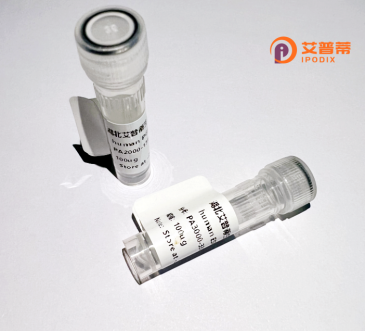
| 纯度 | >90%SDS-PAGE. |
| 种属 | Human |
| 靶点 | KRTHA6 |
| Uniprot No | O76013 |
| 内毒素 | < 0.01EU/μg |
| 表达宿主 | E.coli |
| 表达区间 | 1-417aa |
| 活性数据 | MLRSGLSGLGSCLPGSYLSSECHTSGFVGSGGWFCEGSFNGSEKETMQFLNDRLANYLEKVRQLERENAELESRIQEWYEFQIPYICPDYQSYFKTIEDFQQKILLTKSENARLVLQIDNAKLAADDFRTKYETELSLRQLVEADINGLRRILDELTLCKADLEAQVESLKEELMCLKKNHEEEVSVLRCQLGDRLNVEVDAAPPVDLNKILEDMRCQYEALVENNRRDVEAWFNTQTEELNQQVVSSSEQLQCCQTEIIELRRTVNALEIELQAQHSMRNSLESTLAETEARYSSQLAQMQCLISNVEAQLSEIRCDLERQNQEYQVLLDVKARLEGEIATYRHLLEGEDCKLPPQPCATACKPVIRVPSVPPVPCVPSVPCTPAPQVGTQIRTITEEIRDGKVISSREHVQSRPL |
| 分子量 | 73.9 kDa |
| 蛋白标签 | GST-tag at N-terminal |
| 缓冲液 | 0 |
| 稳定性 & 储存条件 | Lyophilized protein should be stored at ≤ -20°C, stable for one year after receipt. Reconstituted protein solution can be stored at 2-8°C for 2-7 days. Aliquots of reconstituted samples are stable at ≤ -20°C for 3 months. |
| 复溶 | Always centrifuge tubes before opening.Do not mix by vortex or pipetting. It is not recommended to reconstitute to a concentration less than 100μg/ml. Dissolve the lyophilized protein in distilled water. Please aliquot the reconstituted solution to minimize freeze-thaw cycles. |
以下是3篇关于重组人KRTHA6蛋白(KRT6A)的相关文献,按研究领域概括:
1. **《Expression of recombinant human hair keratin in Escherichia coli》**
- **作者**: Lee, YJ. & Coulombe, PA.
- **摘要**: 首次报道利用大肠杆菌表达系统重组生产人毛发特异性角蛋白KRTHA6.优化了包涵体复性工艺,并验证重组蛋白形成的纤维结构与天然角蛋白相似,为体外研究毛发结构提供新工具。
2. **《KRT6A mutations promote Wnt/β-catenin signaling in pachyonychia congenita》**
- **作者**: Smith, FJD. et al.
- **摘要**: 研究先天性厚甲症中KRT6A基因突变的影响,通过重组KRTHA6蛋白证实突变体异常激活Wnt通路,揭示其在皮肤角化异常中的作用机制。
3. **《Recombinant Keratin 6A protects corneal epithelial cells from UV-induced apoptosis》**
- **作者**: Chen, Z. et al.
- **摘要**: 发现重组KRTHA6蛋白可抑制紫外线诱导的角膜上皮细胞凋亡,机制涉及ROS清除和JNK通路调控,提示其在眼表保护中的潜在应用价值。
*注:KRTHA6为KRT6A的别名,由于命名差异,部分文献使用K6或Keratin 6A表示。若需具体文章DOI或补充文献,可进一步说明研究方向。*
Keratin-associated protein 6 (KRTHA6), also known as hair keratin type II cuticular Ha6. is a structural protein predominantly expressed in human hair and nails. It belongs to the keratin-associated protein (KAP) family, which forms intermediate filaments crucial for the mechanical strength and elasticity of epithelial tissues. Specifically, KRTHA6 interacts with type II keratins to stabilize hair shaft cuticle cells, contributing to the protective barrier function and structural integrity of hair.
Genetically encoded by the *KRTAP6* gene cluster on chromosome 21q22.1. KRTHA6 is rich in cysteine residues, enabling disulfide cross-linking that enhances hair's resilience against environmental and chemical stress. Mutations in related keratin genes are linked to hereditary hair disorders, making KRTHA6 a subject of interest in studying hair fragility syndromes and alopecia.
Recombinant human KRTHA6 protein is produced via heterologous expression systems (e.g., *E. coli* or mammalian cells) for in vitro studies. Its purification allows functional analyses, including protein-protein interactions, keratin network assembly, and cytotoxicity assays. Researchers utilize it to model hair development pathologies, screen therapeutic compounds targeting keratinization defects, and engineer biomimetic materials. Recent applications also extend to cosmetic science, evaluating hair-care products aimed at repairing damaged cuticles. As a molecular tool, recombinant KRTHA6 bridges structural biology insights with translational research in dermatology and trichology.
×